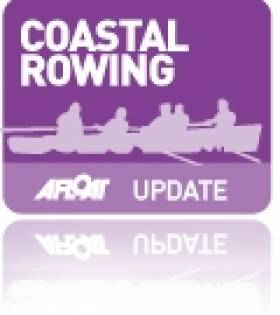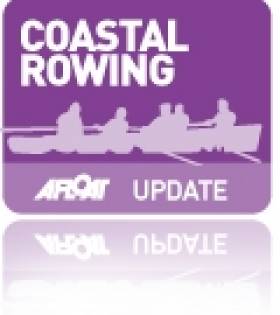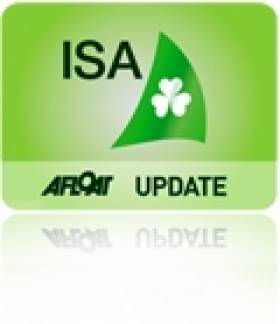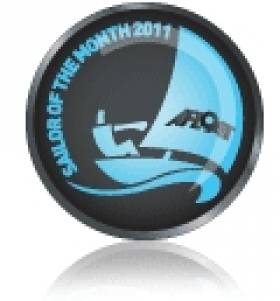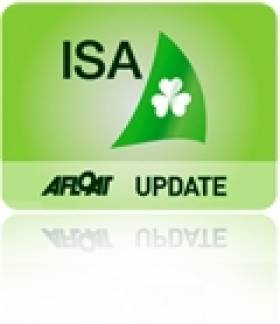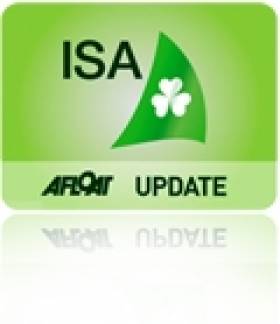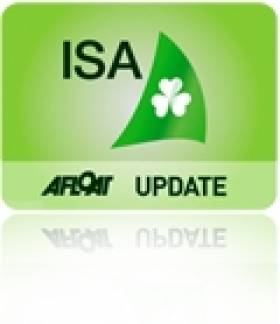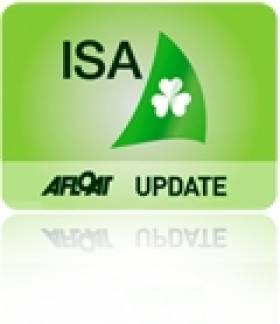Displaying items by tag: All Ireland
Courtmacsherry Crowned Coastal Rowing Champions
#AllIrelandCoastal: Courtmacsherry were deemed Simply the Best as they won the big one, the senior men’s title, at the All-Ireland Coastal Rowing Championships at Carnlough in Co Antrim today. Ring took second place. The senior ladies title was retained by Cairndhu, with Ring again second.
All-Ireland Coastal Rowing Championships, Carnlough, Co Antrim (Selected Results)
Men
Senior: 1 Courtmacsherry, 2 Ring, 3 Kilmacsimon
Intermediate: 1 Passage West, 2 Arklow, 3 Carnlough
Junior: 1 Workmens, 2 Cairndhu, 3 Ring
Under-21: Courtmacsherry
Open Classic: 1 Castletownbere, 2 Cairndhu, 3 Carnlough A
Cork Yawl: 1 Whitegate, 2 Passage West, 3 Rushbrook.
Heritage: 1 St Patrick’s A, 2 St Patrick’s B, 3 St Michael’s
Masters: 1 Passage West, 2 Whitegate
Pre Vet: Courtmacsherry.
Veteran: 1 Portmagee, 2 Passagewest
Under-16: Passage West
Women
Senior: 1 Cairndhu, 2 Ring, 3 Kilmacsimon
Fisa Doubles: Arklow. Fisa Singles: 1 Arklow A , 2 Cairndhu, 3 Arklow B.
Open Classic: 1 Cairndhu, 2 Castletownbere, 3 Carnlough A.
Intermediate: 1 Cairndhu, 2 Portmagee, 3 East Ferry
Cork Yawl: 1 East Ferry, 2 Passage West, 3 Whitegate
Heritage: 1 Killurin, 2 St Kerin’s, 3 St Michael’s
Under-21: 1 Ring, 2 Portmagee, 3 Galley Flash
Under-18: Portmagee
Junior: 1 Courtmacsherry, 2 Templenoe, 3 Arklow
Masters: 1 Galley Flash, 2 Kilmacsimon, 3 Rushbrooke
Pre Vet: Cairndhu A
Mixed
Senior: Fossa
Vet: Cairndhu
Coastal Rowers Converge on Carnlough for All-Ireland
#AllIrelandCoastal: The All-Ireland Coastal Rowing Championships have drawn an entry of 361 crews from 35 clubs (equivalent to 1800 rowers competing) to Carnlough in County Antrim this weekend. Competition begins today and runs through to Sunday. The organisers hope to have live webcam coverage on livestream
Friday Race Order – Start Time 4pm.
1. Open Classic Men
2. Open Classic Ladies
3. FISA X2 Men
4. FISA X1 Ladies
5. Cork Yawl Men
6. Cork Yawl Ladies
7. FISA X2 Ladies
8. FISA X1 Men
Saturday Race Order – Start Time 9am.
1. Mixed Vets – Heat 1
2. Mixed Vets – Heat 2
3. U12 Girls – Final
4. U21 Ladies – Final
5. Senior Mixed – Heat 1
6. Senior Mixed – Heat 2
7. U16's – Heat 1
8. U16's – Heat 2
9. U14 Girls – Heat 1
10. U14 Girls – Heat 2
11. Masters Ladies & Masters Men – Final
12. Heritage Ladies – Final
13. Heritage Men – Final
14. U18's – Heat 1
15. U18's – Heat 2
16. U16 Ladies – Heat 1
17. U16 Ladies – Heat 2
18. Vet Ladies – Heat 1
19. Vet Ladies – Heat 2
20. U14's – Heat 1
21. U14's – Heat 2
22. Junior Ladies – Heat 1
23. Junior Ladies – Heat 2
24. Intermediate Men – Heat 1
25. Intermediate Men – Heat 2
26. Senior Men – Heat 1
27. Senior Men – Heat 2
Sunday Race Order – Start Time 9am.
1. Vet Men
2. Senior Mixed
3. U12's
4. Pre-Vet Mixed
5. U18's
6. Vet Ladies
7. U16 Girls
8. U14's
9. Pre-Vet Men
10. U18 Ladies
11. Mixed Vets
12. U21's
13. Pre-Vet Ladies
14. U14 Girls
15. U16's
16. Intermediate Ladies
17. Junior Ladies
18. Senior Ladies
19. Intermediate Men
20. Junior Men
21. Senior Men.
35 clubs, 361 crews which equals 1800 rowers participating.
All Ireland Sailing Champs to be Reviewed
#ALL IRELAND SAILING – The All Ireland Sailing Championships are set for a revamp following an Irish Sailing Association decision to overhaul its Senior, Junior and Girls competition.
The review follows comments about the system used for participation in 'Ireland's most prestigious sailing event'. Now an ISA review group is to look at all aspects of the 'ISA All Ireland Sailing Championships'.
On this website last October Wayfarer National Champion Trevor Fisher who was not invited to attend wrote 'many dinghy class national champions were not invited to take part'. The full article is here. The Fisher article provoked a lot of comment.
The article was read over 2,000 times and drew further pertinent remarks from many key sailing stakeholders, inlcuding past Presidents of the Association.
For example West Cork's David Harte said: "I believe there should be two All Ireland Sailing sailing championships, one Dinghy Championship and one Keelboat Championship. The Keel boat event should be held in the J80 and what I am offering is the Dinghy event be held in the TR3.6 of which we have 25 identical boats that would cover all National Champions in all Dinghy classes that hold a national championships, similar to the Endeavour Trophy"
To read more of the comments made at the time click here and scroll to the bottom of the article.
Some of those involved in seeking the review are now aiming to make recommendations on how these events might be restructured to best obtain tangible benefits for the ISA and Irish Sailing.
The members of the review group are Flor O'Driscoll (current J24 National Champion and regular participant in the Championship), Ciara Peelo (Ireland's representative in the Laser Radial at the 2008 Olympics), Ed Alcock (ISA Racing Manager). The Group will be chaired by Malahide sailor Neil Murphy, former ISA President.
A short online survey has also been designed and will be circulated shortly to classes and former participants in the event. The survey will also be open to all ISA members. The Group will also consider any points that sailors wish to make about the events and how they might be adapted to follow developments in the sport.
The ISA are seeking contributions but give just over two weeks (February 4th) for submissions.
Doran to Defend Junior Sailing Title
#YOUTH SAILING – The Royal St. George Yacht Club stages the All Ireland Junior and Girls Sailing Championships this weekend in a fleet of nine Firefly dinghies. The invitational championship, which will see 18 of Ireland's leading junior sailors compete for the title of 2011 Champion, was originally scheduled for late October but scrubbed because of a bad weather. The bad news for the event this weekend is that Saturday's forecast is also poor with 50 mph gusts to hit Dublin Bay.
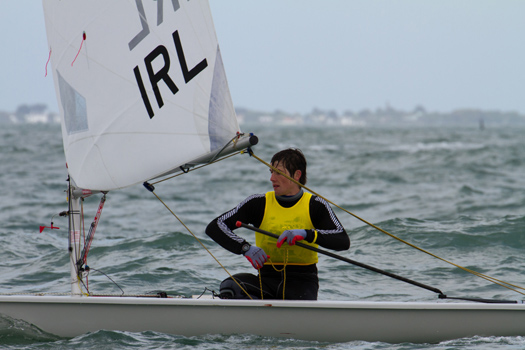
Philip Doran is set to defend his Junior title on Dublin Bay this weekend. Photo: Gareth Craig
Having placed 10th at the ISAF Youth World Championships earlier this year, 2010 champion Philip Doran will be eager to defend his title. He'll face some fierce opposition though in the form of Seafra Guilfoyle who came 2nd at the Laser 4.7 European Championships as well from some of the younger competitors such as Patrick Crosbie, who this year came 3rd in the Topper World Championships, and Eoin Keller who won the Laser National Championships, to name but two.
Also defending her 2010 Girl's title will be Sophie Murphy who had an outstanding year, coming third in the U18 ISAF Youth World Championships. However six other girls will be ready to challenge her for the prestigious accolade including Emma Geary, who as a 420 sailor is experienced in double handed boats and some of the younger sailors such as Sophie Browne who is ranked 1st Senior Optimist sailor in Ireland.
Each competitor will sail with one crew member of their choice in one of the nine Fireflies. On Saturday the teams will be separated into two flights (groups) and will sail three races each. The same flights will then sail an additional two races on Sunday with the top three teams in each flight progressing through to the medal race.
The 18 competitors taking part in the 2011 ISA Junior & Girls All Ireland Sailing Championships are:
|
|
Name |
Club |
Class |
Male / Female |
|
1 |
Kerri-Ann Boylan |
Skerries Sailing Club |
Mirror |
Female |
|
2 |
Sophie Browne |
Tralee Bay Sailing Club |
Optimist |
Female |
|
3 |
Patrick Crosbie |
Royal Cork Yacht Club |
ISA Pathway |
Male |
|
4 |
Fiona Daly |
Tralee Bay Sailing Club |
ISA/420 |
Female |
|
5 |
Tiarnan Dickson |
Lough Ree Sailing Club |
Mirror |
Male |
|
6 |
Sean Donnelly |
National Yacht Club |
Optimist |
Male |
|
7 |
Philip Doran |
Courtown Sailing Club |
ISA Pathway |
Male |
|
8 |
Gregory Fay |
Dungarvan Harbour Sailing Club |
Topaz |
Male |
|
9 |
Emma Geary |
Royal Cork Yacht Club |
ISA Pathway |
Female |
|
10 |
Robbie Gilmore |
Strangford Lough Yacht Club |
Laser Radial Male |
Male |
|
11 |
Laura Gilmore |
Strangford Lough Yacht Club |
Topper |
Female |
|
12 |
Seafra Guilfoyle |
Royal Cork Yacht Club |
Laser 4-7 Male |
Male |
|
13 |
Eoin Keller |
Lough Derg Yacht Club |
Laser Radial Male |
Male |
|
14 |
Peter McCann |
Royal Cork Yacht Club |
ISA Pathway |
Male |
|
15 |
Sophie Murphy |
Royal St George Yacht Club |
ISA Pathway |
Female |
|
16 |
Lisa Smith |
Greystones Sailing Club |
RS Feva |
Female |
|
17 |
David Whittaker |
Royal Cork Yacht Club |
RS Feva |
Male |
|
18 |
Adam Hyland |
Royal St George Yacht Club |
Optimist |
Male |
George Kenefick is October's Sailor of the Month
The 23-year-old helmsman won the Quarter Ton Classics Corinthian Division in July with his immaculately-restored boat Tiger, racing against a top lineup in the Solent. That performance saw him recruited to helm the English-owned boat Chimp in the Half Ton Worlds at the same venue in August. Kenefick showed the quality of his abilities by interacting with a crew he'd never sailed with before to become overall winner against an impressive international fleet.
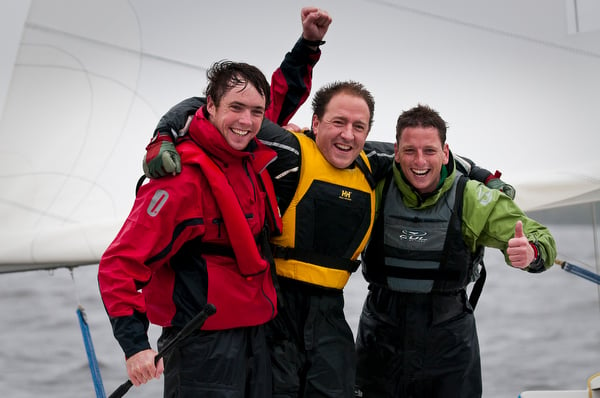
George Kenefick, Mel Collins and John Downey celebrate their win on Lough Derg. Photo: Brendan Fogarty
Back in home waters, next up was the Waterways Ireland ISA National Championship on Lough Derg in the ISA's SailFleet flotilla of J/80s at the beginning of October. For this series Kenefick recruited Crosshaven clubmates John Downey and Mel Collins as crew. The opposition included former champion Mark Mansfield, who had returned to competitive sailing by winning the 1720 Europeans in Baltimore against a fleet including Anthony and Nicholas O'Leary, both former Irish Open Champions.
It went right down to the wire, with Mansfield and O'Leary emerging well ahead on 12–points apiece. On the countback, Kenefick was the new champion. Almost immediately, he was back in the thick of logistics and personnel organization in taking the Cork Institute of Technology sailing team to France for the Student Worlds, CIT representing Ireland as winners of our national series.
With sixteen college teams from all over the world, even in resources-rich French sailing the organizers were stretched in finding an evenly-matched fleet of sixteen Archambault keelboats. There were top class new boats, but some not so new boats, and a trio of boats well past their sell-by date. It was all in the luck of the draw, and the Irish and much-fancied Portuguese found themselves drawing the shortest straw.
In a demanding series, the Portuguese were never at the races with their tired mount, but the Irish simply refused to give up despite a boat which, with its equipment, was falling apart. There was ample opportunity to do this, as the series in the Bay of Biscay off La Trinite included some really rough stuff. In fact, the Irish revelled in the strong breeze, but in the light airs which settled in as the week drew on, it took pure skill.
By the final races last Saturday, they'd got themselves an unassailable third position, but the two British teams – defending champions are allowed an extra place – had miscalculated the points situation. So on the final day, they team raced, one of their boats sailing the Irish crew down the fleet in the best Ben Ainslie style. It was the first time Ireland had finished outside the top six, but they still had the bronze, the Brits took silver, and the French were well ahead to win overall.
More from WM Nixon in the Irish Independent here
Nice to be Invited to the All Ireland Sailing Championships
Wayfarer Dinghy National Champion Trevor Fisher was not invited to sail in last weekend's Waterway's Ireland ISA All Ireland Sailing Championships. Here he outlines why and suggests the system for participation in 'Ireland's most prestigious sailing event' needs an overhaul. (First published: 12th October 2011)
For many people, the opportunity to sail in an event such as the 'Waterways Ireland All Ireland Sailing Championships' would be welcome, for some it would be the highlight of the summer sailing season. Why would it not be welcome? You have the chance to sail against some of the best sailors in the country, Olympic competitors, sailors who race week in, week out and work hard to promote their classes and develop sailing on the island. How does that opportunity come about? Previous winners include some of the best dinghy sailors that Ireland has produced, and without doubt, all winners of the event have been worthy champions.
In years gone by, participation in the event appeared to be straightforward – you won your class national championships and were invited by the ISA. In recent years, the event seems to have changed. It is now appears to be predominantly sailed for by keelboat sailors and the nomination / invitation process is unclear. Classes with 4 Irish based boats at their national championships were invited and represented, but other classes with higher attendance figures were not invited (but were nominated). This year, 2 of the 16 invitees won their dinghy classes national championships and were invited - many dinghy class national champions were not invited to take part. Invitees included the 3rd placed and 8th placed helm from 2 dinghy classes but not winners of other dinghy class national championships.
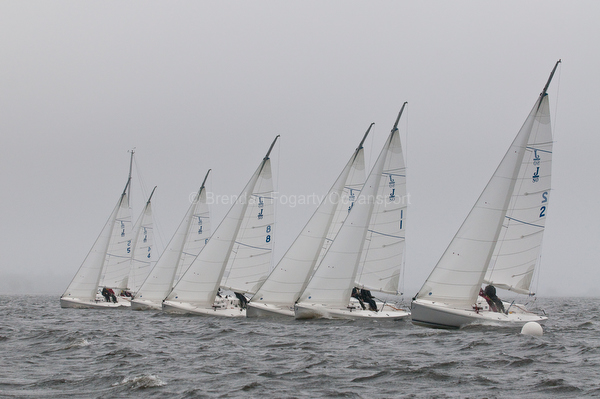
Racing at the All Ireland Sailing Competition. Photo: Brendan Fogarty
Interestingly, on the Yachts & Yachting home page today, 10th October, the ISA All Ireland Championship is included in the KEELBOAT NEWS section of the website. Of the 16 participants in this year event, 10 were invited from keelboat classes, one from multihulls, one as an Olympic invite and 4 from dinghy classes. Is this reflective of the current state of racing in the country? Perhaps it is. Is it reflective of the current state of dinghy racing in the country – I don't think so. The UK equivalent of the ISA All Ireland Championship is the highly prestigious 'Endeavour Trophy', sailed for by the winners of many dinghy national championships in the UK. No keelboats are invited. Is it time for a change? I don't know. Is it time for a debate......I believe so.

A start at this year's Endeavour trophy. Photo: Sue Pelling
So why am I asking these questions? Is this 'sour grapes' on my part? – It looks like it! Am I just a disgruntled dinghy sailor with a chip on my shoulder – possibly! Do I think the process for taking part in the event is not equitable and transparent? - Yes. A number of people that I have spoken to feel the same way and have asked many of the questions that I ask here. I don't begrudge any of this years invitees the opportunity of taking part, but would like the ISA's process for issuing invites clarified. There should be a transparent and equitable process.
So...there is a background. Many years ago, I raced a variety of classes and sailed in the Helmsman's Trophy (as the All Ireland Championship was then called) as both helm and crew. It was always a prestigious event, with the majority of participants coming from dinghy classes. All of the previous winners have been talented racers, from a range of classes.
I returned to sailing three years ago and now race Wayfarers in my local club. Having won the national Championships in 2010, I was nominated for the All Ireland Championships. I was not invited and was informed by the ISA that the only reason was that the Wayfarers didn't use an ISA National Race Officer for their event. The Notice of Race makes it clear that championships should be run under the management of an ISA National Race Officer (although classes not in compliance with this provision may be included in a later draw for invitations). I clarified that this was the sole reason that the Wayfarer class did not get an invite and this was confirmed – fair enough – the ISA have rules and I now knew the process for the following year!
In 2011, the Wayfarer class sailed a joint UK and Irish National Championships as part of the Volvo Dun Laoghaire regatta. This was a fantastic event, well, with 30 boats taking part. The Wayfarers were the biggest dinghy class, second biggest one design fleet (SB3s had a few more boats) and third biggest fleet (IRC 3) had a few more boats. Again, I won the Irish Nationals and was nominated to take part, but did not receive an invite. When I sought clarification, I was told that the Wayfarers only had three Irish boats competing in the fleet of 30, which is not the case. 11 Irish boats took part, including 3 from Greystones SC, one from Cullaun SC, one from Dun Laoghaire and 6 from East Down YC. Although the Wayfarer is affiliated to the Irish Sailing Association, it appears that the 6 boats from East Down YC are not classed as Irish boats, despite being members of the Irish branch of the Wayfarer association, affiliated to the ISA. This had not been an issue in 2010, when there was a larger contingent from EDYC in the Wayfarer nationals.
On the 29th September, the ISA website stated the following:
All Ireland Sailing Championships, Royal Cork's Nicholas O'Leary will not be defending the title when the 2011 event is sailed in two weeks time. Names of the 16 invitees, drawn from dinghy and keelboat classes, were published today. Among those attending is O'Leary's father Anthony representing Cruiser Class Zero and his Crosshaven club mate, the 2011 1720 National Champion Mark Mansfield, a past winner of the event.
Nicholas O'Leary is one of 12 invitees – either national champions or top ranked sailors – who are unavailable to attend. Only 16 of 28 invitees had accepted the invitation by last week's entry deadline.
I would like the ISA to give some clarity to a number of issues surrounding the Waterways Ireland ISA Sailing Championships.
I would like the following information:
What is the selection process for issuing invites to the nominated classes (and for determining which nominated classes will not be invited)? Who decides who is invited and what are the criteria for determining this?
Who were the 28 invitees mentioned on the ISA website? Were they all National Champions, who won their class championships (or were the top ranked sailor in the class)?
How many people were nominated, but did not get invites? What classes were these?
Are some classes 'weighted' i.e. is there a requirement for a class to have a certain number of entries at its nationals? Why would one class, with 5 boats at its nationals, get an invite, yet another class with higher attendance, not?
Why were some participants in the event invited, who did not win their national championships (GP14, Fireball), when other winners of national championships were not invited?
Did all of the invitees win a national championship that was run under the management of an ISA National Race Officer? How many invitees were nominated from classes who did not have their national championship run under the management of an ISA National Race Officer? If there were any, why were they nominated ahead of classes who used an ISA National Race Officer?
Why was the event changed from a 3 day to a 2 day event, when there were a number of nominees who had not been invited to take part? In recent years, participants have been aware that the event was run over three days.
The ISA should confirm (or otherwise) that all invitees who attended were nominated before the closing date for nominations and that invitees accepted their invite before the relevant closing date.
Why were classes who had made a nomination not informed that they would not be invited to the event?
How is the number of Olympic nominees determined?
I have been told by the ISA that next year the event will be limited to 16 invites, will be sailed in J80s and will be sailed over 2 days. It is entirely feasible that next year they may be additional Olympic invites, additional keelboat nominations (Puppeteer / Dragon / Etchells / J109 / Sigma / Shipman etc) further reducing the likelihood of active, small classes getting invited to the event. This year, there were no participants from the Laser / Radial / 4.7, 420, 505, Shannon One Design, Mirror, Topper, Topaz, Wayfarer, National 18s, Laser 2000, RS200 and 400. If all of these classes are keen to take part next year, it is inevitable that many top helms, from a range of classes will be unable to take part. Is this a fair way to determine who the 'All Ireland Champion' is?
I believe that the requirement for classes to run their national championships under the management of an ISA National Race Officer should be an aspiration rather than a requirement. It may be difficult for smaller classes to achieve this and there are many competent regional race officers available. If a sailor were to come through an event that was run by someone other than an ISA National Race Officer, and then get the experience of sailing in an event such as the All Ireland Championship, they will likely see the benefit of using more experienced and qualified race officers, but to make it a requirement of small classes, is, in my view detrimental to these classes who are trying to develop their class structure and racing.
Is it time to split the event? Should there be a dinghy and keelboat event? There have always been and always will be discussion surrounding the most appropriate boat to use and this discussion will roll on and on. There are probably lots of valid reasons for using one class or another, but from an outsiders perspective, there is a fleet of 26 TR3.6 dinghies in Schull, recently constructed for the World Team Racing Championships – would these be available for an All Ireland Championships?
The ISA does a lot of work, in a range of areas, and is funded by the Irish Sports Council to do so. According to the Irish Sports Council website, the ISA currently gets over €1 million from the Irish Sports Council, including over €550k is 'High Performance Funding' and over €300k in 'Core Funding'. Surely an organisation that relies so much on the public purse needs to be and appear to be more transparent and equitable in its operation?
I do believe that the All Ireland Championships, which to many is a highlight of the year (Champion of Champions), should have a clearly defined, equitable and transparent process for nominating and inviting helms to take part. This does not appear to have been the case in 2011 and the answers obtained from the ISA to date, combined with the information on the website, have been contradictory and unclear.
Trevor Fisher
Kenefick Wins as Royal Cork Sailors Take 1,2 in All Ireland Champs
23-year old sailor George Kenefick of Royal Cork Yacht Club is the 2011 Waterways Ireland All Ireland Sailing Champion after the tightest of finishes on Lough Derg this afternoon. Kenefick tied with club mate Mark Mansfield on 12 points but won on the tie break rule.

George Kenefick, Mel Collins and John Downey celebrate their win on Lough Derg. Photo: Brendan Fogarty/ISA. More Photos below.
Kenefick with a last minute crew combination of Mel Collins and John Downey led the fleet over eight windward leeward courses in strong and breezy conditions. The J80 fleet were used in reef down mode as the breeze topped 20-knots. Mansfield was on top after race seven but a final race win for the Half Ton class representatitves gave victory to the young Crosshaven helmsman.
11 points adrift, Olympic 49er campaigner Ryan Seaton from Belfast lough finished third. Full Results below.The youngest of the 16 competing helms Kenefick was up against some tough opposition. A previous winer of the Junior All Ireland Sailing Championship in 2006s he won the Half Ton Cup in 2011. Kenefick becomes the sixth consecutive Royal Cork winner of the ISA Salver trophy.
Kenefick is back on the water in France later this month as Captain of the CIT entry at the Student Sailing Championships in La Rochelle.
FINAL 2011 ALL IRELAND RESULTS
|
Name |
Club |
R1 |
R2 |
R3 |
R4 |
R5 |
R6 |
R7 |
R8 |
Pts |
Disc |
Net |
|
George Kenefick |
Royal Cork Yacht Club |
1 |
1 |
2 |
1 |
5 |
3 |
3 |
1 |
17 |
5 |
12 |
|
Mark Mansfield |
Royal Cork Yacht Club |
2 |
2 |
1 |
2 |
1 |
5 |
1 |
3 |
17 |
5 |
12 |
|
Ryan Seaton |
Ballyholme Yacht Club |
3 |
2 |
2 |
3 |
7 |
1 |
5 |
5 |
28 |
7 |
21 |
|
Ben Duncan |
Howth Yacht Club |
4 |
6 |
4 |
8 |
3 |
4 |
2 |
2 |
33 |
8 |
25 |
|
Flor O’Driscoll |
Howth Yacht Club |
1 |
1 |
3 |
4 |
8 |
6 |
6 |
6 |
35 |
8 |
27 |
|
Gordon Patterson |
Royal North Yacht Club |
4 |
4 |
4 |
6 |
2 |
2 |
8 |
7 |
37 |
8 |
29 |
|
Noel Butler |
ISA |
2 |
3 |
6 |
7 |
4 |
7 |
7 |
4 |
40 |
7 |
33 |
|
Adrian Allen |
Ballyholme Yacht Club |
8 |
3 |
3 |
5 |
6 |
8 |
4 |
8 |
45 |
8 |
37 |
All Afloat's All Ireland coverage here
Eight Line up for Breezy All Ireland Finals
Three Cork keelboat sailors top the fleet after today's qualifying rounds of the Waterways Ireland All Irieland Sailing Championships at Lough Derg Yacht Club. Royal Cork's George Kenefick leads on four points. Flor O'Driscoll, orignally from West Cork but sailing under the Howth YC burgee this weekend, is second on five points. Sharing the same points is four time Olympic Star sailor Mark Mansfield.
Gale force winds are forecast for tomorrow's final on Lough Derg.
Half of the invited helms have been eliminated and although a pre-event favourite Anthony O'Leary has been the major surprise casualty of the event so far, others that failed to qualify included Roger Bannon, Brian Goggin, David Gorman and Alan Henry.
Also through to tomorrow's final is Olympic dinghy campainer Ryan Seaton, one of three Belfast Lough sailors to make it in to the final eight. Seaton's club mate Adrian Allen is also through as is Squib sailor Gordon Patterson from Royal North.
The only Dun Laoghaire sailor through is Fireball ace Noel Butler.
Final Flight Competitors:
|
Name |
Club |
R1 |
R2 |
R3 |
Total |
|
George Kenefick |
Royal Cork Yacht Club |
1 |
1 |
2 |
4 |
|
Flor O’Driscoll |
Howth Yacht Club |
1 |
1 |
3 |
5 |
|
Mark Mansfield |
Royal Cork Yacht Club |
2 |
2 |
1 |
5 |
|
Ryan Seaton |
Ballyholme Yacht Club |
3 |
2 |
2 |
7 |
|
Noel Butler |
ISA |
2 |
3 |
6 |
11 |
|
Gordon Patterson |
Royal North Yacht Club |
4 |
4 |
4 |
12 |
|
Adrian Allen |
Ballyholme Yacht Club |
8 |
3 |
3 |
14 |
|
Ben Duncan |
Howth Yacht Club |
4 |
6 |
4 |
14 |
Kenefick, Mansfield, Allen and Duncan Progress to All Ireland Finals
Racing is taking place in flight two this afternoon in gusty 12 knot winds under race officer Geoff O'Donoghue of Lough Derg Yacht Club.
All three Dun Laoghaire helms competing in this morning's first flight were eliminated. Missing the cut by a single point are Mermaid champion Roger Bannon, David Gorman of the Flying fifteens and Alan Claffey of the Ruffians. Also going home is Donegal GP14 Champion John McGuinness.
Flight 1 Results|
Flight |
Boat |
Name |
R1 |
R2 |
R3 |
Total |
|
1 |
7 |
George Kenefick |
1 |
1 |
2 |
4 |
|
1 |
1 |
Mark Mansfield |
2 |
2 |
1 |
5 |
|
1 |
2 |
Adrian Allen |
8 |
3 |
3 |
14 |
|
1 |
6 |
Ben Duncan |
4 |
6 |
4 |
14 |
|
1 |
5 |
Roger Bannon |
5 |
5 |
5 |
15 |
|
1 |
3 |
Alan Claffey |
6 |
4 |
6 |
16 |
|
1 |
8 |
David Gorman |
3 |
7 |
7 |
17 |
|
1 |
4 |
John McGuinness |
7 |
8 |
8 |
23 |
O'Leary Not Defending 'All Ireland' Title
The only hat-trick winner of the Irish Sailing Association's (ISA) All Ireland Sailing Championships, Royal Cork's Nicholas O'Leary will not be defending the title when the 2011 event is sailed in two weeks time. Names of the 16 invitees, drawn from dinghy and keelboat classes, were published today. Among those attending is O'Leary's father Anthony representing Cruiser Class Zero and his Crosshaven club mate, the 2011 1720 National Champion Mark Mansfield, a past winner of the event.
Nicholas O'Leary is one of 12 invitees – either national champions or top ranked sailors – who are unavailable to attend. Only 16 of 28 invitees had accepted the invitation by last week's entry deadline.
The Waterways Ireland sponsored event takes place at Lough Derg Yacht Club which was originally scheduled for three days but is now running on the 8th and 9th of October only. The event is raced in J80's.
The 16 invitees are as follows:
|
Name |
Club |
Class |
|
Adrian Allen |
Ballyholme Yacht Club |
Multihull |
|
Roger Bannon |
National Yacht Club |
Mermaid |
|
Noel Butler |
ISA |
Fireball |
|
Alan Claffey |
Royal St. George Yacht Club |
Ruffian |
|
Ben Duncan |
Howth Yacht Club |
Laser SB3 |
|
Brian Goggin |
Kinsale Yacht Club |
ICRA '2' |
|
David Gorman |
National Yacht Club |
Flying Fifteen |
|
Alan Henry |
Sutton Dinghy Club |
IDRA 14 |
|
George Kenefick |
Royal Cork Yacht Club |
ICRA '3' |
|
Mark Mansfield |
Royal Cork Yacht Club |
1720 |
|
John McGuinness |
Moville Sailing Club |
GP14 |
|
Flor O'Driscoll |
Howth Yacht Club |
J24 |
|
Anthony O'Leary |
Royal Cork Yacht Club |
ICRA '0' |
|
Pat O'Neill |
Clontarf Yacht & Boat Club |
E-Boat |
|
Gordon Patterson |
Royal North Yacht Club |
Squib |
|
Ryan Seaton |
Ballyholme Yacht Club |
Olympic 49er |




























